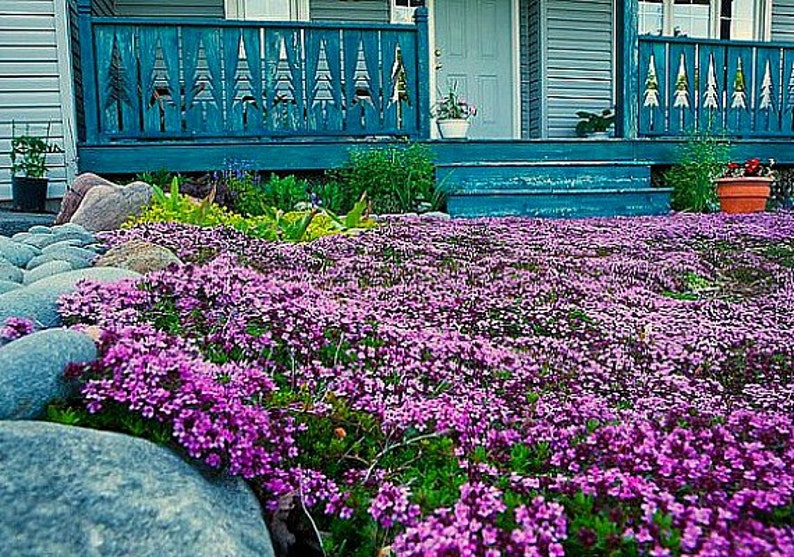
Creeping Thyme is perfect for rock gardens, walls, bare spots in sunny beds and borders, and just about any area in a garden where some quick, permanent coverage is needed. Creeping Thyme blooms all summer attracting bees and butterflies, and its evergreen foliage is attractive even when not in bloom.Ĭreeping Thyme is a super-vigorous, lemon-scented, brightly-flowered variety of thyme that spreads in the sunny garden, giving months of deep-pink blooms and heavenly fragrance. Creeping Thyme produces numerous, thin, somewhat woody stems that form a flat 6-8 inches tall mat of attractive foliage with tiny rounded, glossy blue-green leaves that are covered by clusters of tiny, tubular, deep-pink, lemon-scented flowers.

Also commonly called Wild Thyme or Mother-of-Thyme, this outstanding herbaceous plant is a creeping, woody based perennial which is primarily used as a ground cover.

Creeping Thyme seeds can be started indoors 6-8 weeks before last frost or directly outdoors in spring.

”If you have a garden and a library, you have everything you need.Creeping Thyme Thymus Serpyllum is a robust, hardy perennial subshrub native to Europe and North Africa. I’ll be repotting the chives when she moves on to a sunnier spot as the weather cools a bit. On a hot afternoon, it’s cool there and the pots are a bit damp, making a fragrant, comfy place for napping. I thought I’d share this picture of Miss Ruby Begonia (my cat) under our big oak tree lounging in the chive flats. Otherwise, leave them alone, harvest and enjoy your herbs this fall. If you live in the northern half of Texas, where it will get colder sooner, prune lightly if the plants look leggy. With cooler temperatures and shorter days, those plants will put on a flush of new growth this fall. But, if you have plants that are all stem with a few leaves at the top, go ahead and cut those stems down to several inches above the soil. You don’t have to prune heavily if the plants still look good. If you live in the southern half of Texas and you haven’t pruned back leggy herbs yet, go ahead and do it now. The lemon balm I pruned to the ground a couple of weeks ago is already showing signs of fresh new growth. So, the upcoming cooler nights should help make our herbs perk up and even put on new growth. Even these herbs, which thrive in hot daytime temperatures, start to suffer when the nights stay above about 75 degrees for weeks on end. Many of our favorite herbs are from very warm environments such as the Mediterranean. When it stays hot at night, as it does here for weeks and weeks, it really stresses the herbs. The plants will love the cooler night temperatures, even if it’s just cooler by a few degrees. I also noticed the forecast lows to be below 70 degrees the next few nights. It’s still very hot here in Texas, but it didn’t break 100 degrees yesterday. Today and tomorrow are forecast to stay in the 90s as well. Don’t over-water the new plants do keep them moist until they settle into their new home. If your thyme is in a container, take it out of the pot and cut the plant in half or in sections for more plants. If you have healthy, thriving thyme in your garden it’s easy to make new plants simply by digging out a section of the plant with roots and transplanting it to another spot. (Click here to read more about propagating herbs.) It will take about 5 to 6 weeks before these seedlings are ready to be planted in a garden or herb container. Propagating thyme from seed is not a quick endeavor. The flavors are very similar–the German is perhaps a little more pungent. German winter thyme grows a little bit stockier than the English, in my experience. If you see a recipe which calls for simply thyme, you can never go wrong using English thyme or the German winter variety. Both types are called Thymus vulgaris or common thyme. There are two different varieties here: German winter thyme, which is an excellent herb to grow in our area and further north in Texas, and English thyme.

Just add water! Salad burnet and dill seedlings. I had very good germination on the thyme seeds. It’s just amazing to me how a little seed pushes itself through the soil and reaches for the sun. The salad burnet and fernleaf dill seeds sprouted. But, I did get germination on several flats I planted last week. I spent a couple of days in lovely San Antonio visiting with a friend from Florida who was there visiting her mother. I didn’t get too much done at The Herb Cottage this week. Cynthia Meredith has been gardening with herbs, reading about herbs, gardening with herbs and discussing herb gardening in Texas for more than 20 years. She has owned The Herb Cottage (for over 10 years, selling herb plants to people all over our state.


 0 kommentar(er)
0 kommentar(er)
